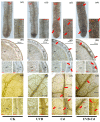UVB-Pretreatment-Enhanced Cadmium Absorption and Enrichment in Poplar Plants
- PMID: 36613496
- PMCID: PMC9820001
- DOI: 10.3390/ijms24010052
UVB-Pretreatment-Enhanced Cadmium Absorption and Enrichment in Poplar Plants
Abstract
The phenomenon of cross adaptation refers to the ability of plants to improve their resistance to other stress after experiencing one type of stress. However, there are limited reports on how ultraviolet radiation B (UVB) pretreatment affects the enrichment, transport, and tolerance of cadmium (Cd) in plants. Since an appropriate UVB pretreatment has been reported to change plant tolerance to stress, we hypothesized that this application could alter plant uptake and tolerance to heavy metals. In this study, a woody plant species, 84K poplar (Populus alba × Populus glandulosa), was pretreated with UVB and then subjected to Cd treatment. The RT-qPCR results indicated that the UVB-treated plants could affect the expression of Cd uptake, transport, and detoxification-related genes in plants, and that the UVB-Pretreatment induced the ability of Cd absorption in plants, which significantly enriched Cd accumulation in several plant organs, especially in the leaves and roots. The above results showed that the UVB-Pretreatment further increased the toxicity of Cd to plants in UVB-Cd group, which was shown as increased leaf malonaldehyde (MDA) and hydrogen peroxide (H2O2) content, as well as downregulated activities of antioxidant enzymes such as Superoxide Dismutase (SOD), Catalase (CAT), and Ascorbate peroxidase (APX). Therefore, poplar plants in the UVB-Cd group presented a decreased photosynthesis and leaf chlorosis. In summary, the UVB treatment improved the Cd accumulation ability of poplar plants, which could provide some guidance for the potential application of forest trees in the phytoremediation of heavy metals in the future.
Keywords: UVB; cadmium enrichment; gene expression; phytoremediation; poplar.
Conflict of interest statement
The authors declare that they have no conflict of interest.
Figures








References
-
- Kumar A., Subrahmanyam G., Mondal R., Cabral-Pinto M.M.S., Shabnam A.A., Jigyasu D.K., Malyan S.K., Fagodiya R.K., Khan S.A., Kumar A., et al. Bio-remediation approaches for alleviation of cadmium contamination in natural resources. Chemosphere. 2021;268:128855. doi: 10.1016/j.chemosphere.2020.128855. - DOI - PubMed
-
- Guo Z., Lv J., Zhang H., Hu C., Qin Y., Dong H., Zhang T., Dong X., Du N., Piao F. Red and blue light function antagonistically to regulate cadmium tolerance by modulating the photosynthesis, antioxidant defense system and Cd uptake in cucumber (Cucumis sativus L.) J. Hazard. Mater. 2022;429:128412. doi: 10.1016/j.jhazmat.2022.128412. - DOI - PubMed
MeSH terms
Substances
Grants and funding
LinkOut - more resources
Full Text Sources
Miscellaneous

